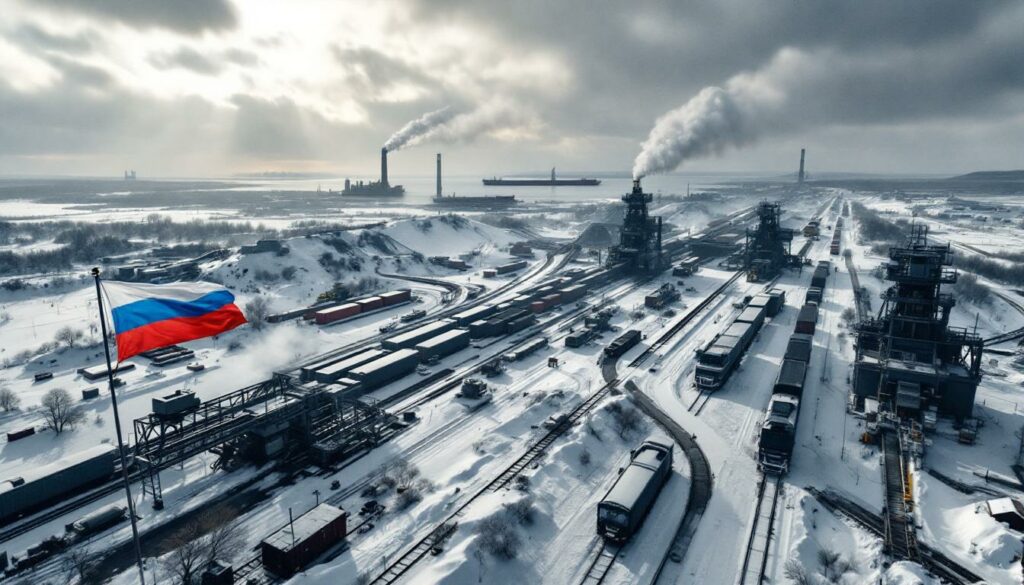How Are Sanctions Affecting Russia's Coal Industry?
Russia's coal sector faces unprecedented challenges due to Western sanctions that have severely restricted exports, financing, and access to critical equipment. Once a powerhouse in global coal markets, the industry now grapples with staggering financial losses and operational difficulties that threaten its very survival.
According to the Russian Energy Ministry, the coal industry recorded losses of 112.6 billion rubles ($1.44 billion) by the end of 2024, with an additional 112 billion rubles ($1.43 billion) in losses between January and May 2025 alone. Industry experts project total losses could exceed 350 billion rubles by year-end if current conditions persist.
"The coal industry faces what you'd call a perfect storm: all problems have converged at once," explains Natalya Zubarevich, a prominent Russian regional economic specialist.
The most visible impact has been the operational shutdown of mining enterprises across the country. At least 51 operations—including both underground mines and open-pit developments—have either completely halted or stand on the verge of suspending activities. This represents more than a quarter of Russia's coal companies facing potential closure.
What Makes Russia's Coal Industry Strategically Important?
Russia's Position in Global Coal Markets
As the world's sixth-largest coal producer, Russia held significant influence in global markets before 2022. The country's vast coal reserves, primarily concentrated in Siberia and the Far East, positioned it as a critical supplier to European and Asian markets.
The geographic distribution of Russia's coal reserves creates both opportunities and challenges. Major mining operations are concentrated in regions like:
- Kuzbass (Kemerovo Oblast): Russia's primary coal basin, accounting for nearly 60% of national production
- Yakutia: Known for high-quality coking coal deposits
- Sakhalin: Strategically positioned for Asian exports
Before sanctions, Russia's coal export infrastructure was well-developed, with specialized port facilities and railway connections designed to move massive volumes to international markets efficiently.
Economic and Social Significance
Though overshadowed by oil and natural gas in Russia's overall energy portfolio, the coal industry remains crucial for several reasons:
- Employment: The sector directly employs hundreds of thousands of workers, with many more in supporting industries
- Regional economies: Dozens of single-industry towns depend almost entirely on coal mining for economic survival
- Export revenue: Pre-sanctions coal exports generated substantial foreign currency earnings
- Domestic energy security: Coal provides approximately 15% of Russia's electricity generation and remains essential for industrial processes
The social implications of the industry's decline are particularly severe in regions like Kemerovo Oblast, where entire communities have developed around mining operations over generations. For these areas, the coal industry represents not just jobs but cultural identity and community cohesion.
How Have Western Sanctions Targeted Russian Coal?
European Union's Complete Import Ban
The most direct hit to Russia's coal industry came in August 2022, when the European Union implemented a comprehensive ban on Russian uranium sanctions as part of its fifth sanctions package. This policy action:
- Eliminated a market that previously absorbed approximately 25% of Russia's coal exports
- Created an estimated €8 billion annual revenue loss
- Forced Russian producers to seek alternative buyers at significantly discounted prices
- Disrupted established logistics and supply chains optimized for European deliveries
The EU ban was particularly damaging because European buyers typically purchased premium-grade coal at favorable prices and with relatively low transportation costs compared to Asian markets.
Technology and Equipment Restrictions
Beyond direct trade limitations, Western sanctions have severely restricted Russia's access to mining technology:
| Equipment Type | Primary Pre-Sanction Sources | Impact of Loss |
|---|---|---|
| Heavy mining machinery | Caterpillar (US), Komatsu (Japan) | Reduced operational efficiency, higher maintenance costs |
| Specialized drilling equipment | Sandvik (Sweden), Atlas Copco (Sweden) | Decreased exploration capabilities |
| Digital control systems | Siemens (Germany), ABB (Switzerland) | Compromised automation and safety systems |
| Mine planning software | Hexagon (Sweden), Bentley Systems (US) | Limited optimization capabilities |
These restrictions create compounding challenges as:
- Existing Western-made equipment begins to deteriorate without proper maintenance
- Replacement parts become unavailable or prohibitively expensive
- Operational safety risks increase as equipment ages beyond recommended service life
- Productivity declines as mines rely on older, less efficient technology
Deputy Energy Minister Dmitry Islamov acknowledged that "the situation continues to deteriorate" as mines struggle to maintain operations with increasingly unreliable equipment.
What Financial Challenges Is the Industry Facing?
Mounting Operational Losses
The financial situation has deteriorated dramatically, with industry-wide losses reaching unprecedented levels:
- 112.6 billion rubles ($1.44 billion) by the end of 2024
- Additional 112 billion rubles ($1.43 billion) between January and May 2025
- Projections suggesting total losses could exceed 350 billion rubles by year-end
Of Russia's approximately 180 coal companies, only about half remain profitable in 2025, with the rest operating at a loss or suspending operations entirely.
The causes of these financial woes include:
- Reduced export volumes: Inability to fully redirect European volumes to other markets
- Price discounts: Necessity to offer substantial discounts to new buyers
- Increased logistics costs: Longer transportation routes to Asian markets
- Rising operational expenses: Higher costs for maintenance and alternative equipment
Debt Crisis and Financing Challenges
The sector faces a perfect storm of financial pressures that threaten its long-term viability:
- Accumulated company debt of approximately 1.2 trillion rubles ($15.34 billion)
- Borrowing costs exceeding 20% interest, making refinancing nearly impossible
- Limited access to international capital markets due to financial sanctions
- Unfavorable ruble exchange rates impacting export competitiveness
- Coal prices at four-year lows in remaining accessible markets
"High debt, weak demand, and coal prices at a four-year low have created an unsustainable financial situation for many mining operations," noted a recent Russian Energy Ministry assessment.
For many companies, this combination of factors has created an impossible financial equation—they cannot generate sufficient revenue to service existing debt, yet cannot access affordable new financing to bridge operational gaps.
How Is Production Being Affected?
Operational Shutdowns and Suspensions
The industry is experiencing widespread operational disruptions that threaten its production capacity:
- At least 51 enterprises have either halted operations or stand on the verge of suspending activities
- More than a quarter of all Russian coal companies face potential closure
- Production volumes have declined significantly compared to pre-sanction levels
- Maintenance schedules have been extended far beyond recommended intervals
These disruptions are not evenly distributed, with smaller and less efficient operations suffering the most severe impacts. The hardest-hit regions include:
- Small and medium-sized mines in the Kuzbass region
- Operations reliant on specialized Western equipment
- Mines with higher production costs due to geological challenges
- Companies with significant debt burdens predating sanctions
Equipment and Technology Challenges
Pre-sanction reliance on Western technology has created critical vulnerabilities that directly impact production capabilities:
- Aging equipment cannot be properly maintained without access to original parts
- Replacement of sophisticated mining machinery has become prohibitively expensive
- Domestic alternatives often lack the efficiency and reliability of Western equipment
- Safety concerns are mounting as maintenance schedules are compromised
Mining operations face increasingly difficult choices:
- Continue operating equipment beyond safe service life
- Attempt to adapt non-specialized parts for critical systems
- Reduce production to conserve remaining functional equipment
- Abandon more technically challenging extraction areas
These challenges have forced many operations to resort to more labor-intensive, less efficient extraction methods, further eroding already thin profit margins.
Where Has Russian Coal Been Redirected?
Pivot to Asian Markets
Russia has desperately attempted to compensate for lost European customers by redirecting coal shipments to alternative markets:
- China: Became the primary destination, absorbing the largest portion of redirected volumes
- India: Emerged as a significant buyer, though often at substantial discounts of 25-30%
- Southeast Asia: Countries like Vietnam and Malaysia increased purchases modestly
- Middle East: Limited success in establishing new market relationships
This geographic pivot has required significant adjustments to Russia's logistics networks, including:
- Expanded capacity at Far Eastern ports like Vostochny and Vanino
- Development of new rail routes to support eastward shipment
- Investment in specialized loading facilities for Asian-bound cargo
- Negotiation of new contracts with unfamiliar terms and requirements
Vulnerability to Market Concentration
This geographic pivot has created new strategic vulnerabilities that threaten long-term stability:
- Overdependence on Chinese demand creates potential for market manipulation
- Limited bargaining power results in accepting lower prices for coal exports
- Higher transportation costs to reach distant Asian markets further erode profitability
- Susceptibility to policy changes in remaining buyer countries
Isaac Levi, analyst at the Centre for Research on Energy and Clean Air (CREA), warns that "any fluctuation in Chinese import activity could significantly impact the industry's recovery and pricing stability."
This market concentration risk is particularly concerning given China's own substantial domestic coal production capacity and its ability to leverage Russia's limited options during price negotiations.
What Government Interventions Are Being Attempted?
Financial Support Measures
The Russian government has implemented various measures to prop up the struggling industry:
- Tax breaks and payment deferrals for coal companies
- Social insurance payment assistance for affected workers
- Subsidized loans for operational continuity
- Regulatory relief to reduce compliance costs
These interventions aim to provide short-term relief while the industry adjusts to new market realities. However, their effectiveness remains limited given the scale of the challenges facing coal producers.
The government's approach has prioritized:
- Preserving employment in coal-dependent regions
- Maintaining critical infrastructure and production capacity
- Supporting the most strategically important operations
- Facilitating transition to new market configurations
Long-Term Structural Reforms
Beyond immediate relief, Russian authorities are considering more fundamental changes to ensure the industry's survival:
- Industry consolidation: Encouraging mining industry consolidation to create fewer, more resilient companies
- Domestic manufacturing: Developing local alternatives to Western mining equipment
- Infrastructure investment: Building new transportation options to reach alternative markets
- Value-added processing: Exploring coal upgrading and processing to increase product margins
These structural reforms face significant challenges, including:
- Limited domestic technical expertise in advanced mining equipment
- High capital requirements during a period of financial constraint
- Long implementation timelines that may not match immediate needs
- Uncertainty about future global coal demand given energy transition trends
The government's ability to successfully implement these reforms will determine whether Russia's coal industry emerges as a smaller but more resilient sector or faces prolonged decline.
What Are the Long-Term Implications for Russia's Coal Sector?
Industry Transformation Scenarios
Experts anticipate several possible outcomes for Russia's coal industry, each with different implications for the sector and broader economy:
- Consolidation scenario: Only the largest, most efficient producers survive, potentially under increased state control
- Domestic refocus scenario: The industry pivots to primarily serve Russian industrial needs
- Innovation pathway: Development of higher-value coal products and clean coal technologies
- Managed decline: Gradual phase-out of less competitive operations while supporting affected communities
The most likely outcome appears to be significant consolidation, with Russia's coal industry emerging smaller but more resilient, focused on serving domestic needs and the most stable export markets.
Broader Economic Impact
The coal industry's struggles reveal wider implications for Russia's sanctions-affected economy:
- Sanctions effectiveness: Demonstrates that Western sanctions are having tangible effects despite Kremlin claims of economic resilience
- Industrial vulnerability: Potential harbinger of similar challenges in other industrial sectors reliant on Western technology
- Regional economic stress: Increased unemployment and economic contraction in coal-dependent regions
- Export revenue diversity: Long-term reduction in Russia's export portfolio diversity
"What we're seeing in the coal sector may be a preview of challenges that will cascade through other Russian industries as sanctions and Russia's coal industry continue to bite," notes one industry analyst.
The coal industry's crisis also highlights Russia's broader economic vulnerabilities in a prolonged period of international isolation, particularly for sectors dependent on global trade, sophisticated technology, and international financing.
What Does This Mean for Global Coal Markets?
Supply Chain Adjustments
The reduction in Russian coal exports has triggered global market realignments:
- European buyers have pivoted to alternative suppliers, primarily from Australia, Indonesia, and South Africa
- Price premiums for high-quality thermal coal have emerged in certain markets
- Logistics patterns have shifted as coal shipments follow new routes
- Investment in alternative production has accelerated in countries not affected by sanctions
These adjustments demonstrate the global market's resilience but also create new challenges:
- Increased shipping distances raise transportation costs and environmental impacts
- Quality differences between Russian and alternative coal sources require technical adjustments
- Price volatility creates planning challenges for both producers and consumers
- New supply dependencies may create future geopolitical vulnerabilities
Environmental and Energy Transition Considerations
The disruption in Russian coal exports coincides with broader energy market transformations:
- Some European buyers have accelerated transitions to renewable energy rather than finding new coal suppliers
- Asian markets continue to show strong demand for coal despite global decarbonization trends
- Market uncertainty has complicated long-term investment decisions in coal infrastructure globally
- Price volatility has increased across energy markets, affecting planning for alternatives
These dynamics create a complex picture for global coal markets, where short-term supply disruptions interact with long-term structural changes driven by climate policies and technological development.
The reduction of Russian coal in global markets may inadvertently accelerate the energy transition in some regions while reinforcing coal dependency in others, creating an uneven pattern of development.
FAQ About Russia's Coal Industry Crisis
How many jobs are at risk in Russia's coal sector?
The industry employs hundreds of thousands of workers, with tens of thousands of jobs directly threatened by current mine closures and operational suspensions. This employment impact is particularly severe in single-industry towns across Siberia and the Far East, where alternative employment options are extremely limited.
Workers in these communities often face difficult choices:
- Relocate to other mining regions (if opportunities exist)
- Attempt to retrain for different industries
- Accept government support while seeking new employment
- Migrate to larger cities with more diverse economies
Could Russia's coal industry recover if sanctions were lifted?
While sanction removal would provide immediate relief, the industry would still face significant challenges:
- Damaged international relationships would take time to rebuild
- Lost market share to competitors like Australia and Indonesia would be difficult to recapture
- The accelerating global energy transition away from coal continues independently of sanctions
- Internal structural problems like high debt would remain
Recovery would likely be partial rather than complete, with the industry unable to return to its pre-2022 position even under the most favorable circumstances.
How does this situation compare to challenges in Russia's oil and gas sectors?
Coal has proven more vulnerable to sanctions than oil and gas for several reasons:
- Lower margins: Coal generally operates with thinner profit margins, making financial stress more immediately threatening
- Stronger competition: Global coal markets have more alternative suppliers than some oil and gas segments
- Strategic priority: Russian government prioritizes oil and gas support due to their larger economic contribution
- Technology differences: Coal mining relies heavily on specific Western equipment with fewer alternatives
This different vulnerability profile explains why visible impacts have appeared in the coal sector before manifesting as severely in oil and gas.
What are the environmental implications of this industry disruption?
The reduction in Russian coal production and exports could potentially impact global carbon emissions in several ways:
- Positive scenario: If replaced by cleaner energy sources, emissions would decline
- Neutral scenario: If production simply shifts to other coal-producing nations, the net environmental impact would be minimal
- Negative scenario: If less efficient producers with lower environmental standards increase production, emissions could potentially increase
The actual environmental outcome depends largely on how energy markets and policies respond to the absence of Russian coal in traditional destination markets.
Further Exploration
Readers interested in learning more about the impacts of international sanctions on energy markets can explore related educational content, including tariffs impact on investments and the trade war commodity impact that continues to reshape global trade challenges.
The Russian coal industry's struggles demonstrate the complex interplay between geopolitics, economic policy, and energy markets—offering valuable insights into how EU sanctions against Russia can reshape global commodity flows and industrial structures in ways that extend far beyond their immediate targets.
Ready to Identify the Next Major Resource Opportunity?
Don't miss out on investment-worthy discoveries across global commodity markets. Explore Discovery Alert's proprietary Discovery IQ model at https://discoveryalert.com.au/discoveries/ to receive real-time alerts on significant mineral findings before the broader market reacts.




